Auctions
The 18 Most Appalling International Art World Scandals of 2015
Our recap on all the juiciest scandals of 2015.
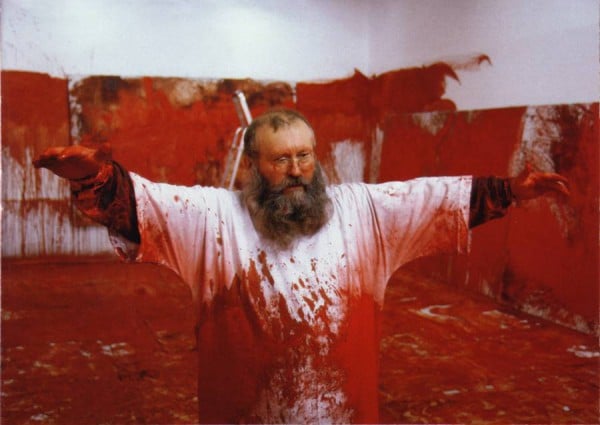
Photo: flavorwire.com
Our recap on all the juiciest scandals of 2015.

Sarah Cascone

It seems as if there’s never a quiet moment in the art world, especially during boom times. There are record-breaking auctions, controversial exhibitions, and even violent episodes by artists, as well as trolling by the general public.
Here’s a quick guide to some of the more scandalous news reports that have happened over the course of this year.

The stabbing victim at Art Basel in Miami Beach.
Photo: Rudy Perez, courtesy the Miami Herald.
1. The Art Basel in Miami Beach Stabbing
Art Basel in Miami Beach, arguably the art world’s glitziest annual event, was the site of perhaps the year’s most shocking scandal when 24-year-old fair-goer Siyuan Zhao allegedly stabbed Shin Seo Young with an X-Acto knife. The vicious crime rocked the art world, forcing the Swiss fair to scramble to do damage control.
The recent graduate of University of Oregon’s architecture program told the arresting officers “I had to kill her and two more!” and “I had to watch her bleed!” Thankfully, the victim’s injuries were treatable.

Yves Bouvier.
Photo: via the Rakyat Post.
2. Fraud Charges Against Freeport King Yves Bouvier
Early this year, Swiss businessman Yves Bouvier, who safeguards millions of dollars-worth of art at his international freeport empire, was arrested in Monaco and indited for fraud. Dmitri Rybolovlev claims that Bouvier jacked up the prices on 38 artworks, including Steve Cohen‘s Amedeo Modigliani nude, which Cohen sold for $93.5 million and Rybolovlev bought for $118 million.
The Russian believed Bouvier was acting as his agent, while Bouvier maintains he was working as a dealer (despite the potential conflict of interest). While maintaining his innocence, Bouvier stepped down from his Freeport post in April, and Rybolovlev has been ruthlessly pursuing his claim. In November, Rybolovlev spoke out against the freeport king, accusing him of trying “to paint me as the stereotypical Russian oligarch.”
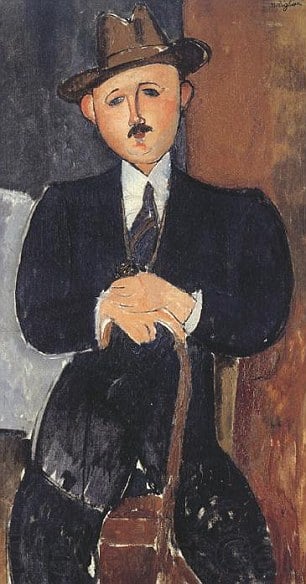
Amedeo Modigliani, Seated Man with a Cane (1918).
3. Helly Nahmad’s Accursed Modigliani
This is the scandal that just won’t go away, no matter how hard the Nahmads try. Since 2011, Philippe Maestracci has been trying his best to reclaim an Amedeo Modigliani painting that once belong this his grandfather, Jewish art dealer Oscar Stettiner. Though the first case against him was dismissed, Nahmad was hit with a court summons over the painting in 2014, and this past month, Maestracci filed suit yet again. The dispute’s final outcome remains to be seen, and Nahmad’s lawyer is quick to deny any wrongdoing on the dealer’s part.
In general, disputes over looted artworks can drag on for years: see the claims over the Guelph Treasure and works by Egon Schiele believed to have belonged to a Viennese cabaret performer who died in a concentration camp, and the recent conflict over a Pieter Bruegel the Elder canvas in Austria that may have been looted from Poland. Works restituted in 2015 included a Ernst Ludwig Kirchner painting from New York’s Museum of Modern Art and an El Greco once linked to the Knoedler Gallery, while the Bristol City Council is going to keep their Pierre-Auguste Renoir seascape.
Two long-running cases involving Camille Pissarro canvases also appear to have been resolved this year. Earlier this month, the University of Oklahoma appeared to agree to return a painting to the French Holocaust survivor whose father originally owned it, while a Los Angeles judge ruled in June that a Spanish museum could not be compelled to return their Pissarro. The Impressionist artist also figured in the tainted collection of Cornelius Gurlitt, with the German Minister for Culture and the Media confirming that a suspect Pissarro from Gurlitt trove had been seized by Nazis.
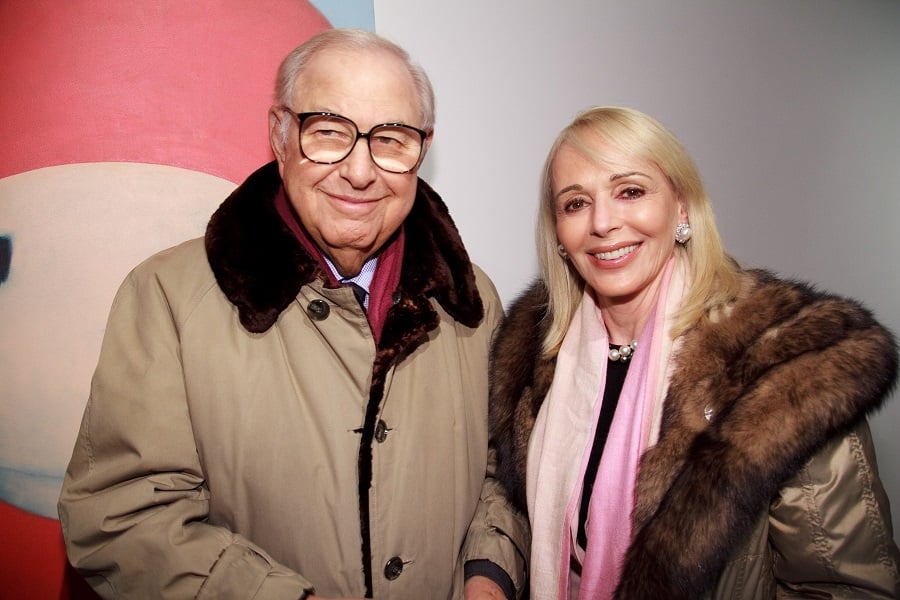
A. Alfred Taubman and wife Judy Taubman.
Photo: Dustin Wayne Harris/Patrick McMullan.
4. Taubman Family Feud
When billionaire art collector and former Sotheby’s owner A. Alfred Taubman died in April it led to many questions: How would the recently-embattled Detroit Institute of Arts be affected? What would become of his $500-million art collection—and later, would Sotheby’s be able to make money on the estate sale despite the massive guarantee? (Results were mixed.)
The scandal, however, was over the ongoing tensions between Taubman’s widow, Judy, and his surviving children from an earlier marriage. In September, Judy found herself locked out of the couple’s London apartment, over an argument with her stepchildren that reportedly centered on two painting worth a collective $300,000. Vanity Fair profiled the feud, with a source saying of Judy that “she hates them and they hate her. Now the kids have a chance to get their revenge.”
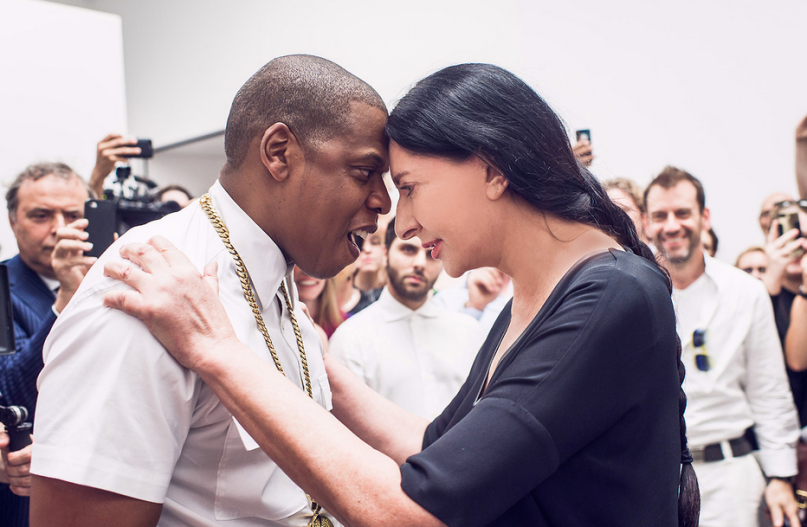
Jay Z and Marina Abramovic during the 2013 shoot for “Picasso Baby.”
Photo via Consequence of Sound.
5. Marina Abramović Calls Out Jay-Z; Gets Owned
The image of Marina Abramović and Jay-Z facing off during the music video for “Picasso Baby,” shot at New York’s Pace Gallery in summer 2013, has been forever sullied (unless you were already turned off by the storied performance artist’s increasingly mainstream fame). In May, Abramović alleged that she had only participated after the rapper agreed to donated to the Marina Abramović Institute—a promise that was never made good on.
“It’s so cruel, it’s incredible,” she told Spike Art Quarterly. In response, Jay-Z quickly offered up a receipt from the institute proving her wrong. Shamefully, Abramović couldn’t admit fault, instead passing the blame along to her staff.
The Jay-Z incident wasn’t her only brush with scandal in 2015: This past month, Abramović again made headlines when a Park Avenue Armory dinner was abruptly cancelled, with the institution informing would-be guests that it was due to the performance artist’s hospitalization—a claim that was later denied. It was all a bit confusing, but hopefully, the health scare isn’t a serious one.
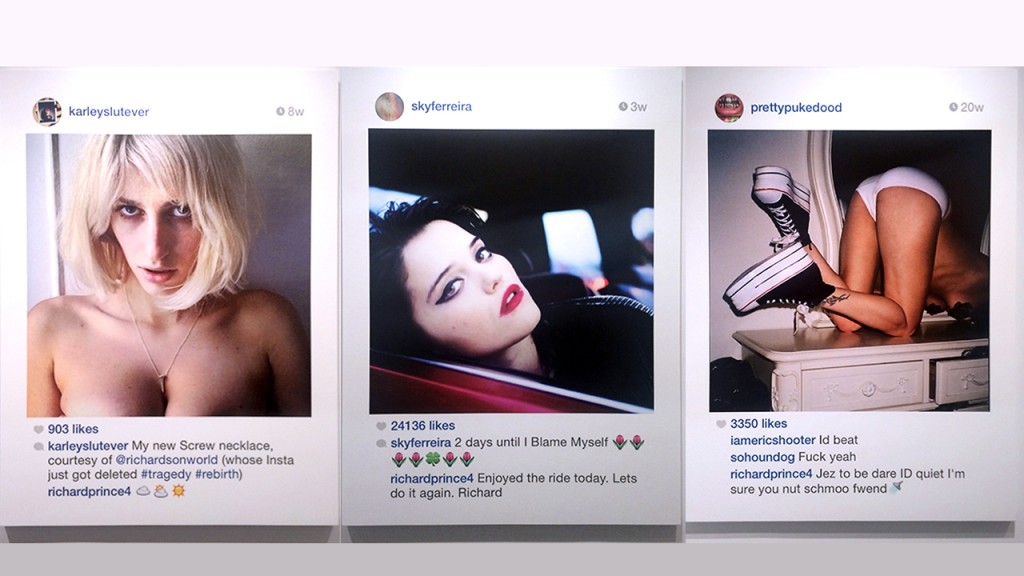
Richard Prince, “New Portraits” at Gagosian Gallery. Installation view.
6. Richard Prince Stealing Instagram Photos
Richard Prince debuted his “New Portraits” series of large-scale prints based on other people’s Instagram photos to less-than-universal acclaim in 2014, but the controversy over the appropriated images really came to a boil this spring.
The prints were widely denounced as vapid, and Prince was criticized for stealing the works of others and selling it for $100,000. Many whose Instagram photos were now appearing at Gagosian Gallery and Frieze New York spoke out against Prince.
The SuicideGirls, a Los Angeles-based alternative pin-up community, took the fight one step further, selling their own copies of the “Richard Prince” works (which were themselves nearly flipped again) for just $90. For those aggrieved Instagrammers looking to take legal action, here’s a guide to how to beat Prince in court.
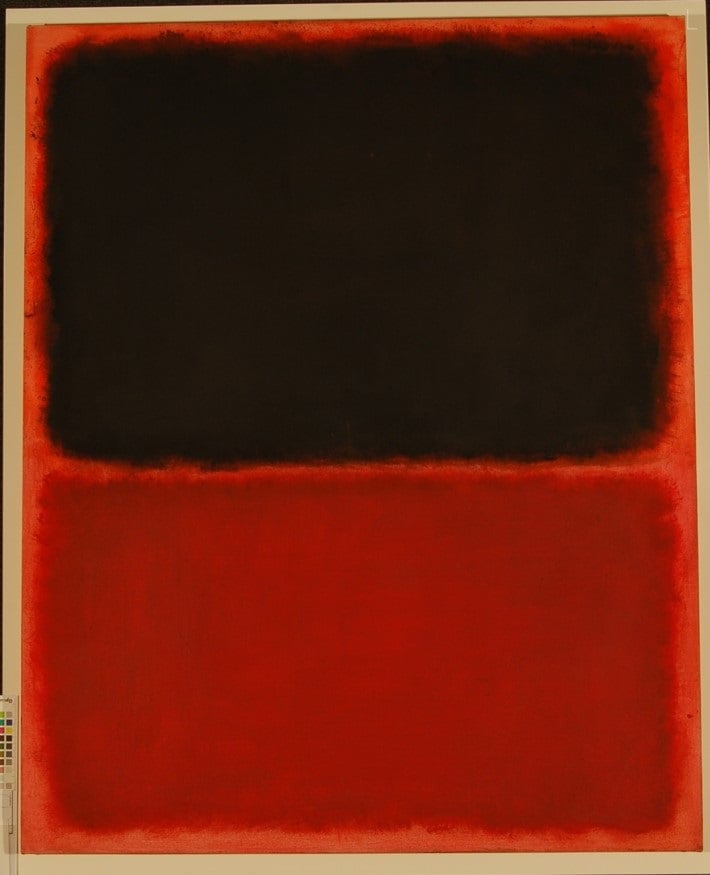
A painting sold by Knoedler as a Mark Rothko that turned out to be fake.
7. The Knoedler Forgery Ring
One claim against Knoedler Gallery was settled out of court earlier this month, but the scandal over the millions of dollars worth of forged artworks sold by the discredited dealer still hasn’t subsided.
The gallery, which closed in 2011, was the center of a forgery ring that passed off the work of Pei-Shen Qian, a Chinese painter in Flushing, Queens, as priceless masterpieces. Former gallery president Ann Freedman has long proclaimed her ignorance of the paintings illicit origins.
While the drawn-out proceedings have been largely-shrouded in secrecy, those following the case closely can look forward to new juicy details on January 25, 2016, when former Sotheby’s executive Domenico De Sole, who was sold a fake Mark Rothko, will finally have his day in court against the shuttered gallery.
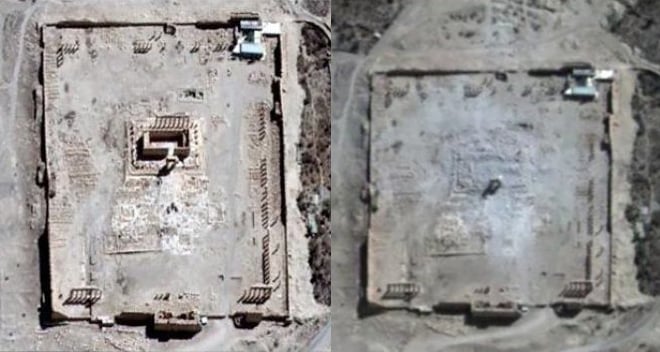
Satellite imagery of the Temple of Bel in Palmyra both before and after ISIS destroyed it. Photo: UNOSAT.
8. ISIS Destruction and Looting of Antiquities
ISIS figured prominently in our list for 2014, and they’ve unfortunately earned top honors once again, terrorizing much of the Middle East and leaving a large swath of destruction in their wake. At the beginning of the year, the world looked on in horror as footage of the destruction of artwork at the Nineveh Museum in Mosul, Iraq, appeared online.
In March, militants flattened the ancient Assyrian city of Nimrud. Soon after, the international community braced for disaster as ISIS forces approached the ancient city of Palmyra. The worst came to pass when ISIS blew up the city’s Baal Shamin Temple, Temple of Bel, and Arch of Triumph. In act of stunning brutality, ISIS also beheaded Palmyra’s 82-year-old archaeological custodian in the city square.
Perhaps most disturbingly of all, however, is that analysis of satellite imagery indicates that ISIS isn’t the only group looting and destroying cultural heritage sites in the region.
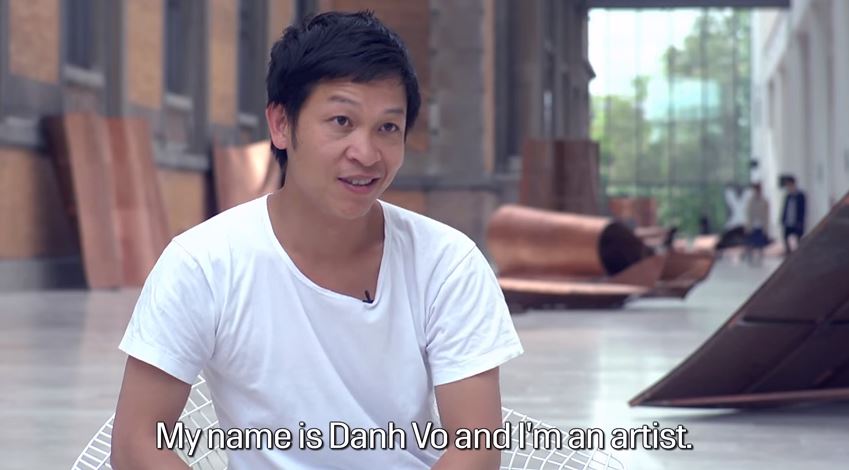
Danh Vo.
Image: Courtesy of YouTube.
9. Bert Kreuk Sues Danh Vō for $1.2 Million
Another holdover from 2014, the bitter dispute between the art collector and Hugo Boss Prize-winner has at least been resolved. In December, two years after Vō was meant to have delivered a site-specific installation for Kreuk, the three parties, who also included the artist’s gallerist, Isabella Bortolozzi, finally reached a settlement.
After six hours of negotiations, Kreuk and Vō agreed to set aside their differences—an impressive feat, given the level of animosity displayed earlier in the year, after a judge initially ruled in Kreuk’s favor. Asked to deliver the promised work in a year’s time, Vō offered a wall-work in which his father would write “SHOVE IT UP YOUR ASS, YOU FAGGOT.” Kreuk, as you might expect, objected to the offensive phrase.
Nevertheless, a settlement was agreed upon, and no money or artwork exchanged hands.
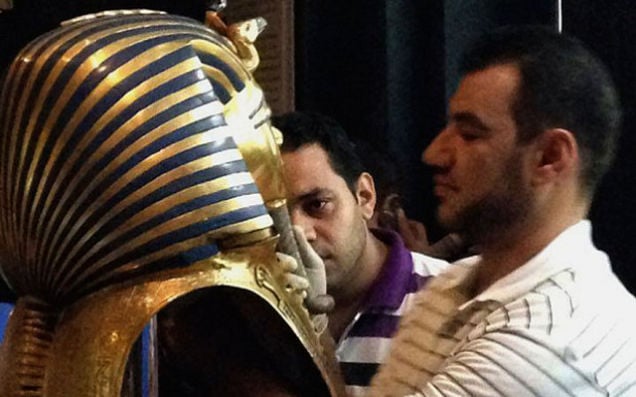
The restoration crew is seen gluing King Tut’s beard back on at the Egyptian Museum in Cairo on August 12th, 2014. Photo: Jacqueline Rodriguez, courtesy the AP.
10. Egypt Breaks King Tut’s Mask
It hasn’t been a great year for art in Egypt, with a number of stolen antiquities appearing on the market, a group of Cairo curators arrested for theft, a terror attack at the El Arish Museum for antiquities, and a foiled attempt to bomb the Luxor Temple.
Perhaps worst of all, however, was when a group of inept museum employees damaged King Tut’s iconic funerary mask and glued it back together with harsh epoxy. (The damage appears to be reversible, and repairs began in October.) Adding to the embarrassment, the boy king’s chair was also damaged this year during transport between museums.
Luckily, we did get to see the original photos of the tomb’s 1922 discovery restored in dazzling color thanks to Dynamichrome.
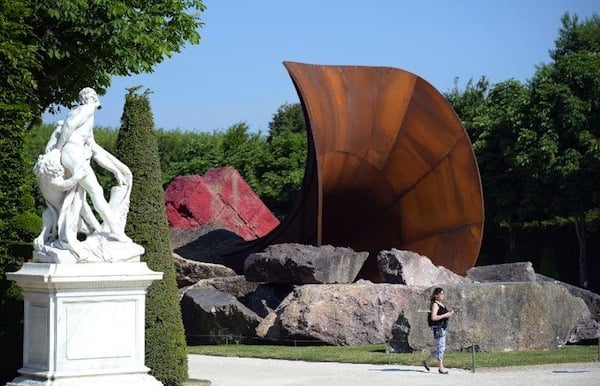
Detail of Dirty Corner
Photo: Stephane de Sakutin via AFP
11. Anish Kapoor’s Dirty Corner
In 2014, Paul McCarthy got punched and his controversial butt plug Tree sculpture was deflated by vandals at FIAC in Paris. This year, France’s most controversial large-scale sculpture installation was Anish Kapoor’s Dirty Corner, part of his solo show at Versailles.
The sculpture, which Kapoor called a symbol of “the vagina of the queen who took power,” caused quite a stir with its sexual imagery. If the initial response was bad, things only got worse after the piece was vandalized not once but four times, once with anti-semitic slogans. Kapoor, who denounced the violent act, originally planned to leave up the offensive graffiti, which further aggrieved the public. He was ultimately forced by the courts to remove the slurs.
Criticism against the artist included a local right wing politician who claimed that Kapoor “has declared war on France.” Kapoor told artnet News that he would fight the court’s decision, and that “if vandalism and hate stops public experimentation, we all lose.”
Kappor also took issue with a Chinese artwork that he perceived as a knock-off of his iconic Cloud Gate sculpture, although Chicago mayor Rahm Emmanuel disagreed.

The Donstsk People’s Republic (DPR) destroy’s Pascale Marthine Tayou’s Transform! (2012), at the Izolyatsia Center for Cultural Initiatives.
Photo: video stills.
12. Russian Separatists Destroy Art at Ukraine’s Izolyastia Center for Cultural Initiatives
A militant Russian-backed separatist group has destroyed a number of contemporary artworks at Izolyatsia Center for Cultural Initiatives in Donetsk, Ukraine.
The center was seized by in 2014 by Donetsk People’s Republic, who announced their intention to “punish” the center for its “perverted” artwork. This June, the group released a shocking video showing the explosion of Pascale Marthine Tayou’s Transform!, a giant lipstick perched on a factory smokestack. Reportedly, large-scale art installations from Daniel Buren, Leandro Ehrlich, and Cai Guo-Qiang have also been looted and vandalized, while Kader Attia‘s Ce N’est Rien has been converted into a prison and interrogation center.
Exiled to Kiev, the center has done its best to publicize its plight, protesting Russia’s occupation of Crimea by hosting a vacation sweepstakes and rally at the Venice Biennale. Maria Kulikovska, whose “Homo Bulla,” a series of soap sculptures at Izolyastia, became objects for target practice, destroyed a new version of the work in a London performance this past month.

Artifacts in the Ethnological section of the Museum of Macedonia, Skopje.
Photo: via wikipedia commons
13. Museum Thefts That Were Inside Jobs
Three art world institutions that fell victim to internal corruption stand out this year: the systematic looting of Macedonia’s National Museum by its director and six other employees, the staff member that looted the archives of the Hermitage Museum in St. Petersburg, and the forgery scheme cooked up at China’s Guangzhou Academy of Fine Arts by its the chief librarian.
The Macadonian thefts were carried out over a period of years, led by former museum director Pero Josifovski, who was sentenced in March to nine years behind bars for his crimes. Over 162 valuable artifacts were stolen from the museum. The Hermitage discovered several missing items during a routine inspection, and soon learned that a staff member had stolen the priceless books and documents and was selling them to antiques dealers.
In China, staff and students were allowed to check out valuable artworks as if they were books. Former chief librarian Xiao Yuan, who pled guilty to replacing 143 original paintings with his own fakes, claimed the archive was riddled with forgeries from his first day on the job. He even suspects some of his own handiwork was later replaced by even shoddier copies.
Meanwhile, in Boston, the public library wound itself up into a tizzy over the suspected theft of prints by Durer and Rembrant. Although an inside job was widely suspected, the staff eventually realized the works had merely been misfiled—but not before library president Amy Ryan had been forced to resign.
(A cleaning crew in Italy also threw out an entire art installation designed to look like the aftermath of a giant party, but that was an accident).
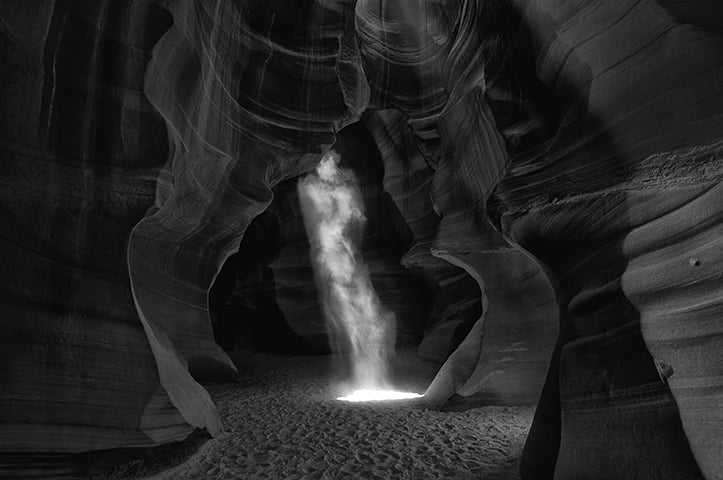
Peter Lik Phantom. Photo: Peter Lik.
14. Peter Lik’s $1 Million Photograph
When Australian landscape photographer Peter Lik announced that he had smashed the record for the world’s most expensive photograph with the $6.5 million sale of Phantom, a black-and-white shot of Arizona’s Antelope Canyon, the art world was understandably confused and skeptical.
The New York Times did some digging, unveiling Lik’s convoluted pricing scheme, in which each of his images is sold in gigantic editions of 995. As a print sells out, the price rises from $4,000 to tens of thousands of dollars—even though the artnet Price Database shows that Lik has only exceeded $3,000 at auction twice, with a $15,860 sale in 2008 and a $9,500 sale this summer.
For Phantom, Lik created an edition of one, pricing the print to match the total income he would have made from a full set of 995 prints. The Internet was not impressed.
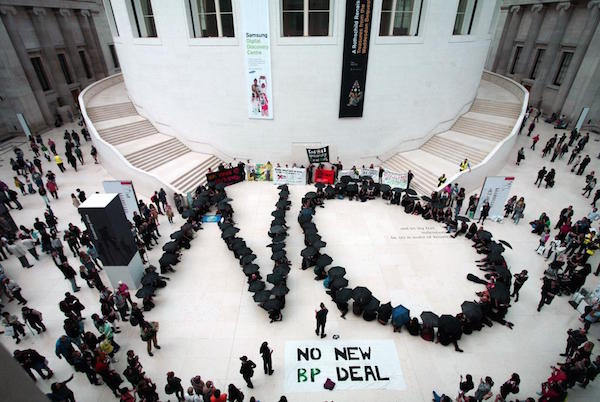
Anti-oil protesters at the British Museum in London, on Sunday September 13, 2015.
Photo: Niklas Halle’n/AFP via Art Daily
15. Museum Protests
The biggest museum protest of the year may have been at New York’s Museum of Modern Art (MoMA), where workers banded together to demand the museum not increase the cost of health care premiums.
The proposed cuts to benefits became even more unpalatable when director Glenn Lowry‘s $2.1 million annual salary was revealed. Workers sent Lowry an open letter, and an agreement, unanimously approved by workers, was soon reached.
Museums were also criticized for theirs ties to high-end developers (the Brooklyn Museum) and big oil, with major protests at the Louvre, and New York’s American Museum of Natural History and the British Museum, Tate Modern, and other London museums.
Meanwhile, art lovers also united against an unlikely target: Pierre-Auguste Renoir, with “protests” at the Museum of Fine Arts Boston, the Norton Simon Museum in Pasadena, California, and the Metropolitan Museum of Art in New York, triggering an impassioned defense of the Impressionist artist.

Ines Doujak, Not Dressed for Conquering.
Photo via: El País.
16. MACBA Director Resigns After Censoring Controversial Sculpture
A racy sculpture by Austrian artist Ines Doujak led to a huge blow up at the Barcelona Museum of Contemporary Art (MACBA) when director Bartomeu Marí took offense to the piece. The “Beast and the Sovereing” exhibition was ultimately cancelled over the work, which depicted former Spanish king Juan Carlos and Bolivian Labor leader Domitila Chúngara involved in a sexual act with a dog, but that wasn’t the end of the story.
Amid widespread outrage over the censorship, Marí was forced to resign, and the two curators responsible were fired. Due to his tarnished reputation, over 600 members of South Korea’s artistic community spoke out against Marí’s possible appointment as director of that country’s National Museum of Modern and Contemporary Art (MMCA). He has since won the job, and pledged to protect freedom of expression.
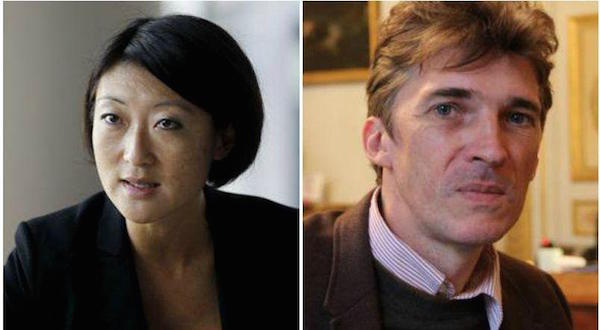
Fleur Pellerin and Nicolas Bourriaud.
17. High-Profile Museum Firings
Never say that the art world doesn’t stand by its own: the international arts community banded together in support of Lorenzo Benedetti, director and curator of Amsterdam’s De Appel, fired in September; Marinika Babanazarova, director of Uzbekistan’s Savitsky museum, fired in August; and Nicolas Bourriaud, director of Paris’s École Nationale Supérieure des Beaux-Arts, fired in July.
Bourriaud’s case was by far the most contentious, with allegations that the Minister of Culture, Fleur Pellerin had dismissed him for nepotistic reasons. A heated, highly-publicized dispute between the two followed.

Hermann Nitsch.
Photo: flavorwire.com
18. Hermann Nitsch Exhibition Cancelled Over Animal Cruelty Accusations
In February, an exhibition of work by Hermann Nitsch was cancelled at Mexico City’s Museo Jumex as a result of a petition accusing the Viennese Actionist of animal cruelty, despite the artist’s insistence that “everybody who knows me knows that I am an animal protector.”
Nitsch uses animals in his “The Orgies Mysteries Theatre” performances, which incorporate blood and carcasses, and mimic crucifixions and mutilations.
Austria’s ambassador to Mexico, Eva Hager, spoke out in full support of Nitsch, calling him “one of Austria’s most important contemporary artists.” Jumex director Patrick Charpenel resigned over the controversy, and was replaced by Julieta González.
There was a similar push to cancel a “The Orgies Mysteries Theatre” production that was held this summer in Palermo, Italy.
Despite the controversy, New York’s Marc Straus gallery held a large exhibition of his work in September.